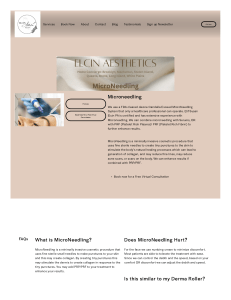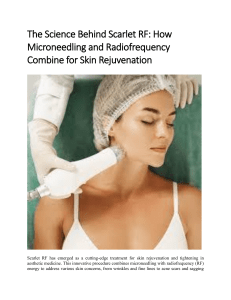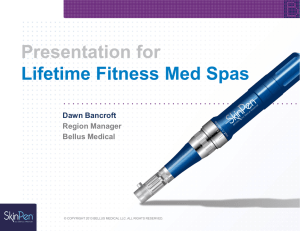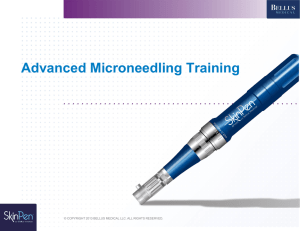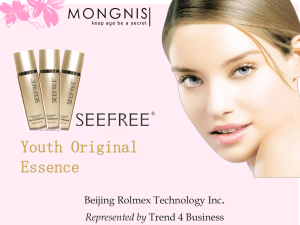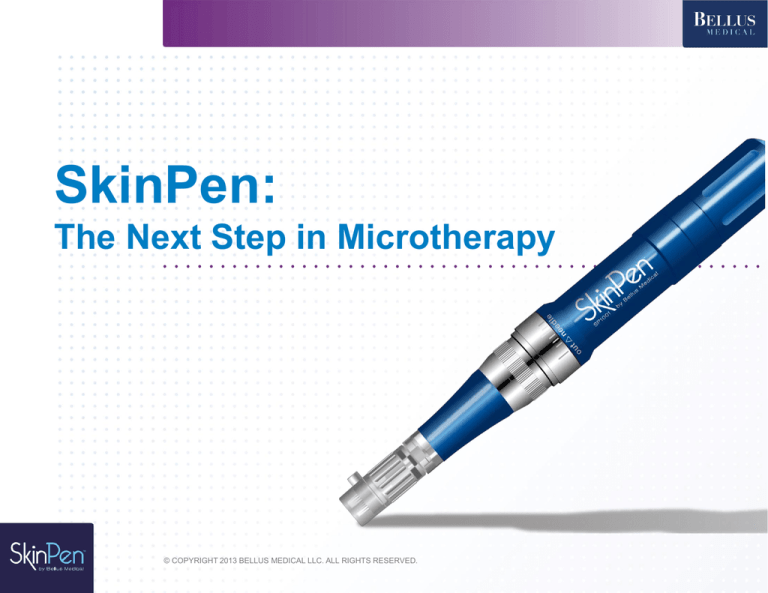
SkinPen:
The Next Step in Microtherapy
© COPYRIGHT 2013 BELLUS MEDICAL LLC. ALL RIGHTS RESERVED.
What is Microneedling?
Microneedling is the procedure by which multiple tiny, sterile needles are used to
create microscopic, closely spaced holes in the skin in order to induce the body’s
natural healing response to produce fresh, new dermal tissues.
•
•
•
Also referred to as Collagen Induction Therapy (CIT) or
Percutaneous
Collagen Induction (PCI)
Depth of needle used can vary based on patient need
Can help with general cosmesis (e.g., anti-aging) or for medical applications (e.g.,
scar tissue revision or to increased penetration of topical medications)
History of Microneedling
Important milestones in the development of microneedling
„1950s: First described by Dr. Michel Pistor1
1995: Subcision is introduced.2
1997: Needle dermabrasion using a “tattoo pistol” to treat scars.3
1998: Dr. Des Fernandes of South Africa presented his findings on needling
at a conference in San Francisco4
2000: Horst Liebl designs his first microneedling medical device
2004: Clinical Resolution Laboratory, a California company, redesigned
the device, called MTS Roller
1. Pistor, M. Presse Med. 1958 Jun 4;66(44):999-1000
2. Orentreich DS, Orentreich N. Dermatol Surg. 1995;21:6543–9
3. Camirand A, Doucet J. Needle dermabrasion. Aesthet Plast Surg. 1997;21:48–51.
4. Fernandes D., Minimally invasive percutaneous collagen induction. Oral Maxillofac Surg Clin North Am. 2006;17:51–63
1.8
Introducing SkinPen
2013: The next step in microtherapy
SkinPen is a medical-grade, state-of-the-art precision tool available
only through skincare professionals.
SkinPen works by creating a series of hundreds of microscopic
channels into the dermis to stimulate the skin’s natural production of
new collagen and elastin, helping skin to look and feel healthier.
Fine lines or moderate
wrinkles
Diminished skin texture,
tone and color
Atrophic acne scars
Stretch marks
Traumatic scars
Photo aging
How Does Microneedling Work?
•
•
•
•
Microinjuries allow for release of serum containing cytokines and growth
factors, important for cell renewal
Promotes deposition of fresh new collagen without scar formation
Creation of microchannels in the skin with minimal damage to epidermis
Microchannels allow
topicals to penetrate
deeper than typically
possible, but only
temporarily (<1 hr)
1.14
Microchannel Formation
Creation of microchannels in the skin
with minimal damage to epidermis*
Microchannels are open
for a short time, which
allows for more efficient
penetration of topicals
Minimal damage to
tissue equals minimal
downtime
*Fernandes, D. OralL Maxillofacial Surg Clin 2005;17:51-63.
1.17
Microchannel Characteristics
These channels remain open long enough to allow for topical penetration, and then close to
begin the natural healing process that leads to new, fresh dermal tissue deposition.
Figure from: The AAPS Journal, Vol. 13, No. 3,
September 2011
1 . 11
Collagen Induction Therapy
What does old vs. young skin look like?*
Biopsy of young skin showing thick
bundles of collagen bundles.
*Abd El-Aal NH, et al. J Dermatol 2012;57:181-6
Biopsy of aged skin showing thin
and loose collagen fibers (MassonTrichrome ×100).
1.20
Comparison with Other Treatments
1.21
Lasers vs. Microneedling
Advantages of CIT over laser treatments
► The biggest differences are cost and treatment recovery time.
► Either will take several sessions to treat your acne scars.
► Lasers run risk of post-inflammatory hyperpigmentation; CIT does not.
► The recovery time is longer between laser treatments than it is with CIT.
► Microneedling helps your body to create more collagen naturally.
► CIT does not burn your skin.
► CIT tightens what is already there.
SkinPen Advantage
Microneedling offers a simple and safe modality
to improve the appearance of acne scars without risk of dyspigmentation in
patient of all skin types
60 patients of skin types phototype I to VI were treated with microneedling
for treatment of acne scars
Three treatments at monthly intervals.
Evaluated by using a Global Aesthetic Improvement Scale (GAIS), and analyzed
statistically by computerized image analysis of the patients’ photographs.
Average reduction of 31% of scarring.
No short- or long-term dyschromia was observed.
Fabbrocini G, et al.. J Dermatolog Treat. 2012 Dec 8. [Epub ahead of print].
1.13
Increased Dermal Thickness
Before
After
Patient had an increase in dermal thickness after 5 months.
Dermal thickness increased from 1.91 mm to 2.41 mm.
Moon, HS et. al; Department of Dermatology, Eulji University School of Medicine
3.4
Recommended Needle Depth
Needle depth is contingent on:
Thickness of dermis in area to be treated:
The dermis of the face is variable, typically no deeper
than 1.5 mm
Dermis in other areas of the body may be thicker or thinner,
with the dermis of the back typically the thickest (~3 mm)
Reason for Treatment:
Facial rejuvenation for improvement of skin texture of fine
lines will require less penetration
Improvement of scar tissue will require a more aggressive
treatment and therefore deeper penetration
Fabbrocini G, et al.. J Dermatolog Treat. 2012 Dec 8. [Epub ahead of print].
Contraindications
SkinPen is contraindicated for patients with:
• A history of keloid scars, scleroderma, collagen vascular diseases or
cardiac abnormalitities
• A hemorrhagic disorder or hemostatic dysfunction
• An active bacterial or fungal infection
Precautions and warnings
SkinPen has not been evaluated in the following patient populations,
and as such, precautions should be taken when determining whether
to treat:
•
•
•
•
•
•
•
•
•
Scars and stretch marks less than 1 year old
Women who are pregnant or nursing
Keloid scars
Patients with history of eczema, psoriasis and other chronic conditions
Patients with history of actinic (solar) keratosis
Patients with history of herpes simplex infections
Diabetics or patients with wound-healing deficiencies
Patients on immunosuppressive therapy
Skin with presence of raised moles or warts on targeted area
Easy Maintenance
For optimal results, it is essential to feed your cells the nutriens they
need to produce fresh, strong extracellular matrix proteins or ECM:
Daily Skin Care Regimen:
1. Gentle cleanse
2. Restore: Topical vitamins A, C, E, hyaluronic acid
3. Protect: Apply antioxidant SPF 30 sunscreen.
Note: Patient should avoid sweaty exercise and sun exposure between days 1 and 3
following microneedling
Little-to-No Downtime!
Post-treatment Expectations
Day 1: Patients should expect mild to moderate swelling and redness, similar
to a mild sunburn. There may be some mild bruising in some patients as
well.
Day 2: Some persisting redness may be present, but all redness,
bruising and swelling should be diminishing. Nothing some clean,
mineral based makeup wouldn’t cover.
Day 3: Most redness, bruising and swelling should be nearly gone. Normal
appearance with makeup may be achieved.
Day 4: Patient should appear mostly normal at this point with some minor
swelling.
Instructions for Use
Possible Side Effects
Side effects are rare with microneedling, especially when using disposable needles.
However, some possible, rare side effects may be:
Allergic reaction to steel or serums used
Robust inflammation of treated area
Persisting itching
Cutaneous eruption
Reactivation of pre-existing HSV
If any of the above effects or any other effects of concern are noted after
treatment, make sure the supervising physician is notified immediately to avoid
further complication.
3.34
Improvement in Atrophic Scars
A F T E R 3 – 4 T R E AT M E N T S
ACNE S CAR
P O X S CAR
BEFORE
34 of 36 patients achieved a reduction in scar severity by one or two grades.*
More than 80% of patients assessed their treatment as “excellent” on a
10-point scale.*
*J Cutan Aesthet Surg. 2009 Jan; 2(1):26–30
3.36
Enhancement of Topical Penetration
MICRONEEDLING + DEPIGMENTING SERUM
DEPIGMENTING SERUM ALONE
BEFORE
AFTER 2 MONTHS
Plast Surg Int. ID 15824. Epub 2011 Apr 7
Microneedling has been
shown to enhance penetration of a depigmenting
serum in a 20-subject study
for treatment of melasma.
Microneedling +
depigmenting serum:
Mean MASI score of 19.1 at
baseline
Mean MASI score of 14.4
(P < .001) at 1 month
Mean MASI score 9.2
(P < .001) at 2 months
Depigmenting serum alone:
Mean MASI score of 20.4
at baseline
Mean MASI score of 17.4
(P < .05) at 1 month
Mean MASI score of 13.3
(P < .05) at 2 months
Before
After
Six weeks after one treatment.
Photos courtesy of Dr. Christie Matter,
North Texas Dermatology
Before
After
Four weeks after one treatment.
Three passes at 1.0 mm.
Photos courtesy of Dr. Christie Matter,
North Texas Dermatology
Before
After
After one treatment.
Photos courtesy of Spectacular Skin
Before
After
After one treatment.
Photos courtesy of Spectacular Skin
Before
After
After one treatment.
Photos courtesy of Spectacular Skin
Before
After
After one treatment. First pass at 0.5
mm; second pass at 1.0 mm.
Photos courtesy of Dr. Ken Oleszek,
LaFontaine Aesthetics
Before
After
After one treatment. First pass at 0.5
mm; second pass at 1.0 mm.
Photos courtesy of Dr. Ken Oleszek,
LaFontaine Aesthetics
Before
After
After three weeks. One localized area
treatment using a 2.0mm needle.
Photos courtesy of the Women’s Centre for Excellence
QUESTIONS?
THANK YOU!!

